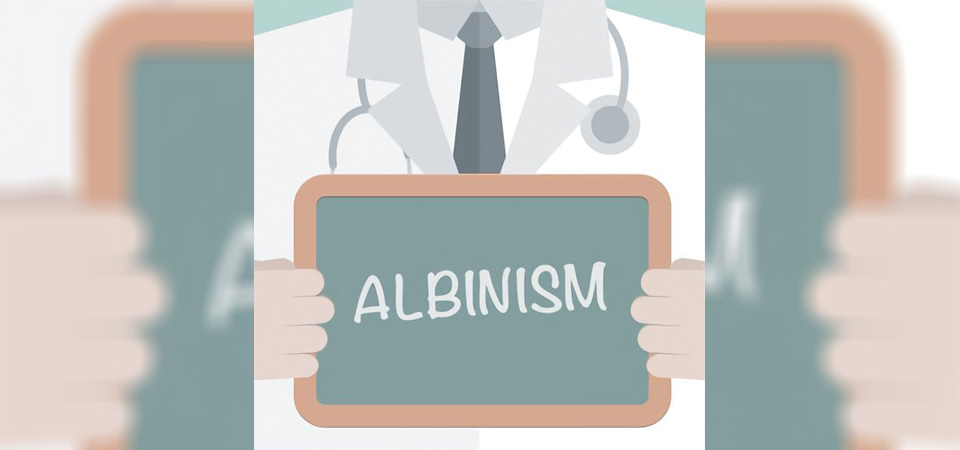Albinos compelled to live with physical, social challenges

Kathmandu, Jan. 27: Rupak Laudari does not like thinking about his school days. It was not a happy time for him as he was teased relentlessly by his friends and even some teachers all through primary and secondary schools. Kuhire, Angrez, Sete, Whitey – these were some of the words the 28-year-old used to hear every day.
Why?
“Because I was an albino,” Laudari said. School was unbearable also for Chandra Shrestha. She even thought of dropping out in her ninth grade because the teasing got so terrible. “Matrix 2 had come out that year and people compared me to the villainous twins (who have blonde hair and pale skin) featured in the movie,” the 32-year-old recalled. “I didn’t know it back then but it was full-on harassment.”
Asked why, she also answered, “Because I was an albino.”
Albinism, or Oculocutaneous Albinism (OCA), is a congenital disease in which a person has partial or complete loss of pigmentation of the skin, eyes and hair. It is caused by mutations in the genes that provide instructions for making one of several proteins involved in the production of melanin.
These genetic mutations interfere with the ability of the melanocytes, melanin-producing cells, to produce the pigment or distribute it to the keratinocytes, the major cell comprising the outer layer of the skin.
Although there are no concrete statistics, it is believed that this condition affects one in 17,000 people in Nepal and according to dermatologist Dr. Vikash Paudel, there is no cure.
Albinism can be a debilitating health condition for people living with them. “People living with albinism have light-coloured skin which is more sensitive to sunlight. As a result, they get sunburnt easily and are at a higher risk of skin cancer,” Paudel, who is a lecturer at National Medical College, Birgunj, said. “Their eyes are also more sensitive to bright lights.”
This means that people with albinism cannot leave their houses as readily as people without can. They have to put on extra-protective sunscreen, wear hats and dark shades to protect their eyes and wear clothing that fully covers their body. “We cannot live as freely and fully as others can,” Laudari said with a sad gaze.
“A freedom further restricted by our society’s attitudes towards albinos,” said Tekraj Jaisi, president of the National Disabled Albino Nepal (NDAN). NDAN, as stated on its website, is an organisation seeking to advocate for the recognition of the genetic disorder and helping people living with albinism achieve their full potential. As its head and an albino himself, Jaisi understands the struggles described by Laudari and Shrestha.
“We are ridiculed, called foreigners and are always the centre of unwanted attention at social functions,” he said. “This prevents many of us from coming out and interacting with others.”
Albinos also have a hard time getting married, Shrestha explained. “People find us unappealing, unattractive and parents are hesitant to accept an albino as their son or daughter-in-law.”
The Nepali community does very little to support people with albinism, she remarked, and Jaisi felt that this was because of a lack of awareness. “There isn’t even a Nepali word for albinism. That’s how less we understand this disease in the country,” he said.
Jaisi said that organisations like NDAN could undertake awareness-raising initiatives but needed support from the government and non-government sectors. “The state as well as non-government organisations should help us collect statistics and disseminate information,” he requested.
Recent News

Do not make expressions casting dout on election: EC
14 Apr, 2022
CM Bhatta says may New Year 2079 BS inspire positive thinking
14 Apr, 2022
Three new cases, 44 recoveries in 24 hours
14 Apr, 2022
689 climbers of 84 teams so far acquire permits for climbing various peaks this spring season
14 Apr, 2022
How the rising cost of living crisis is impacting Nepal
14 Apr, 2022
US military confirms an interstellar meteor collided with Earth
14 Apr, 2022
Valneva Covid vaccine approved for use in UK
14 Apr, 2022
Chair Prachanda highlights need of unity among Maoist, Communist forces
14 Apr, 2022
Ranbir Kapoor and Alia Bhatt: Bollywood toasts star couple on wedding
14 Apr, 2022
President Bhandari confers decorations (Photo Feature)
14 Apr, 2022









